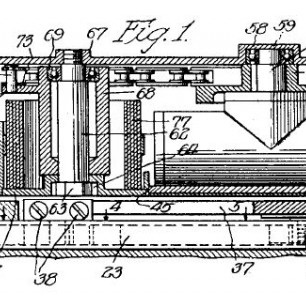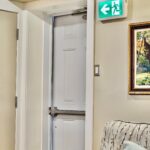I previously posted Part 1 and Part 2 of this article, and here is the third and final segment.
A Memoir from 1880 – How I Discovered Door Checks
by L.C. Norton, Inventor of Door Checks
_______________________________________________________
In the August 1986 issue of Doors and Hardware, Norton described his troubles with manufacturing and selling the door check. In this final segment, Norton crowns his career with successful experiments with an elevator check and an overhead concealed closer.
Norton was asked to compile this history by his partner, D.R. Lasier. The company finally founded in 1926 came to be known as LCN Closers in 1948. The manuscript was uncovered recently when someone at LCN headquarters in Princeton, IL, was looking through old records stored in an unused desk.
_______________________________________________________
This being knocked about from pillar to post gave the big four, the Yale Co., Corbin Co., Russell and Erwin, and Sargent, the opportunity to take advantage of our distress and boom up the liquid door closer business. This came very near putting the Norton door check out of running. Up to 1908 we were still making the air checks, while the big four were well equipped in the liquid door closer line and were pushing their door closers all over the county with great success.
With the big four fully equipped in the door check line, and each one with a capital of around 20 million, if I wanted to stay in the race, I would have to have a liquid door check.
There was a serious question. We had opened up the field for door checks with our pneumatic or air check, and had already spent over $50,000 to put it on the market. Now the big four were selling their liquid checks on the strength of our air checks, so the question was: “Shall we build a liquid door check in competition with the big four, and if we did, could we expect to compete with four companies of twenty million each, with our small capital?”
Naturally, I say no, it is impossible. Unless a much superior article could be designed which could be sold at the same price, or a little less. I set myself to work to see what could be done.
All of the liquid door checks operated the door in the same way. There was no checking of the door until it reached an angle of about 45 degrees which brought a strain on the door, the hinges, and the door check. All these checks were operated by a crank motion or its equal. While this was good, much better than a slam, in my mind it was far from being the ideal way to operate a door. So, I reasoned this way. If I should make a liquid door check, it must have these features:
- It must control the door through its entire swing;
- It must begin to check the door from the time it starts to close, so the wind pressure would have no effect;
- It must check backwards as well as forward, to prevent the door striking the wall or injuring the door knob;
- It must have two speeds, one all the way up to within a few inches of the latch and another to control the door at the latch; and
- It must be constructed to close the hardest right at the latch, to overcome a stiff latch, or close against the wind.
Of course, this was asking a good deal, but if all these points could be obtained, it would pay me to undertake to put such a device on the market and face the tremendous competition that was sure to follow.
Well, I began my experiments by using a crank style design, and tried in every way to make it check the door all the way, but it was no use. A crank was a crank, and would do its best work at only one point in the swing of the door. The rest was all bad, so I had to give up the crank style entirely. The next was the shuttle motion working square across the piston. This was not much better than the crank style, as it had a dead center, and would cease to work just where I wanted it to work the fastest.
The next was the slide motion something like the shuttle motion, only working across the piston at an angle of 45 degrees. This design was very good, but still would not operate all the way, as I wished. So that was laid aside.
The next trial was a rack and piston and that did the trick. The movement of the piston was uniform, and started to control the door from wide open, but in order to get the most power in closing the latch, I had to get it by the use of the toggle arms. Then to get the check to work backwards as well as forwards, I had to use a double-headed piston, which worked completely.
Then I needed to get the two speeds. I had to use a regulating screw with two parts, one at each end of the cylinder, which gave us any speed we wanted up to the latch and the same screw gave us the regulation at the latch. Thus, we got all the five points.
The results of these experiments were very encouraging, and we proceeded at once to make patterns and build our first liquid door closer. This closer was built with the checking cylinder close to the door and the shaft outside, but later on, we changed this, having the shaft nearest the door and the cylinder outside, which is practically the way the closer looks today.
The First Elevator Check
It was about this time, when we were not too busy, that my son Clifford picked up a model I made of an elevator door check and said he was going to sell some. I told him it was not perfected yet, as in the last experiment we put one on an elevator running 300 feet per minute, and the elevator tore the fixture off and dropped it down the well. But Clifford took his model and went off and came back with an order from the Blackstone Hotel for $1800 worth of elevator checks. Therefore, I had to build them. Clifford continued this work until he had sold about every hotel in Chicago, and also most of the hospitals. This attracted the attention of the Otis Elevator Co. and also the Elevator Supply Co., as a result the latter bought the device.
We took a contract back to manufacture the cylinders for them. This worked out nicely until Clifford and a Mr. Graham made a company of their own to make these elevator fixtures. This soon worked itself into a million dollar company, and finally was taken over by the Otis Elevator Co., where it is now in 1937.
Competing Companies
We were now running very smoothly, with little competition, except with the big four, where we were continually having more or less trouble, mostly on the price situation. After about 1912 our business was growing very fast, and we were very well established all over the United States. But, it was interesting to note in the years 1912 to 1924 how many different designs of door checks came out and tried to get on the market.
Door checks made in or about Boston were the Norton, Elliot, Clark and Gillon, Eclipse, Columbia, Laurimer and some others, all of them air or pneumatic styles. Those made in Chicago were mostly of the liquid style like the Stronach. The liquidless checks were the Rixson, Will, Smith, and several others.
Those made in different parts of the country were the Worcester Blount. Two men from the Yale and Towne Co. went to Worcester and built what they called the Worcester-Blount, made exactly after the pattern of the regular Blount check. This was after the patents expired so they had a right to make it. A suit was brought by the Yale and Towne Company for using the name “Blount,” but the court decided in favor of the Worcester Company as they used the name Worcester-Blount and not just Blount.
Then there was the Yale, nearly the same as the Blount. The Corbin 98 was fairly good. Then followed the Corbin 99 which was the best check Corbin made. Then the Corbin Rack and Pinion. Then the Russwin. Then the Bardsley, Tolen and Ogden, which were of the flower pot style operated by a screw design. The Becker, Richard Wilcox, Bayer-Gardner and Hynes, with the spring in the arms, Kant Slam, Victor, Jobson and quite a few names I don’t remember.
Now, after about 1900 we got interested in a door check placed in the floor, both single and double-acting, they were not found practical – cost too much to make and the price was too high and not enough of a demand.
It seems it was left to Rixson, who was an architect, to design and build a good floor check. He did and had the exclusive field in that line for many years. About this time, when we were thinking of making a floor check to compete with Rixson, I asked the Corbin people why they were not pushing their floor check. They said, too much trouble, expensive to make, and when they had any sale for a floor check, they used the Rixson.
However, we went ahead and designed and built a floor check for both single and double swing doors. After several experiments we decided on one, but they never came into general use while I was interested in the Norton Door Check and Spring Co.
Selling the Business
From 1912 to 1913, we made 22,000 door checks and made a good profit. In 1913 to 1914, we made 35,000 door checks, besides a large quantity of elevator checks and screen door checks, at a good profit. Every year increased the business, until 1924, we made 100,000 door checks, at a very handsome profit. The book value of the stock was increased from $10 a share to $43 a share.
This was very interesting to the Yale and Towne Co. who had invested some money in our company at the start, and with such a showing, they desired to acquire the whole company. They did, paying the book value for it, and they are still operating at the Chicago plant. The selling out of the company put me out of business and I felt a great relief, as I had put in a lifetime of extremely hard work.
It was all right for me and the stockholders who also sold their interest on a four to one basis, but Mr. Lasier, the manager, who had been with me for six years and done some very valuable work, was out of a job. He wanted me to help him make a door check to sell. I said, “I am going out of the business, not into it.” Well, he asked me to go in for say two years, and he would start a new business. The result was the organizing of the Norton-Lasier Co. This was in 1925.
Nearly all of the door check companies I have mentioned have had their day, and disappeared, leaving only the Rixson, the Norton, and ourselves, besides the big four (the Yale Co., Corbin Co., Russell and Erwin, and Sargent), in the business.
There seemed to be something about this door check business that was hard to manage. The manufacturing end seemed simple enough, but when it came to the selling end, that was a problem hard to solve.
The big four were well-established all over the country, and their door closers were good enough to pass the architects on all building operations. Therefore, for a new company to get any of this business, they must first have a superior article, the price must be lower and their closers must take the place of some one of the closers now being carried by the hardware trade. The cost of such an undertaking would ruin any ordinary company. In fact, it had already wiped out nearly every undertaking in the door closer line.
Now, for two men to come out from the Norton Co., who had years of experience in building door closers, and put out a new and improved door closer, called the LCN is what the Norton-Lasier Co. was up against. It took considerable courage to take up and carry out such an undertaking.
The door closer that the Norton-Lasier Co. proposed to put out was quite similar to the Norton. I had the rack and pinion, the two speeds, the quiet closing and quick release, and back check. All of which were valuable, but the interior work was quite different. The weak places in the Norton had been corrected, improvement in the shaft and packing made, so it was impossible for the closers to leak, which was a very important item on my list of requirements. The new company had this advantage: many of the Norton customers were made so by square dealing, high-class work and workmanship, and believed that what the company said was really so. Customers were glad to go with us in the this new deal. To show what the trade thought of this new door closer – and the company – there is one instance that is worth mentioning. One of the salesmen for the Norton Co., a Mr. Frank Ryan, went with us and the first day out he went around to the trade to tell them of this new LCN door closer and the value of the improvements made over the Norton. He came in with orders for over 11,000 closers, being the largest day’s sales by any one salesman we ever knew. This was in 1925 and 1926 and the company was getting a fine start.
Sometime before this, I had moved my family to California, as it was not the intention that I should stay in active work at the factory for any length of time. After three or four years, I went back to California for good.
Experimenting with Concealed Closers
It was then I took up some experimental work on concealed door closers. The Los Angeles General Hospital was being built at this time, and was to have several thousand door checks. I submitted a full-sized model of a floor closer to the authorities, which they liked very much, but in the floor it was not sanitary. Mr. Bergstrom, the chief architect, said if I could put the closer up overhead, I would be doing something. I at once saw I could do it and went to work and rebuilt the floor closer. I had a full size door and frame, and at once installed the closer in the jamb overhead. this pleased Mr. Bergstrom very much, and he gave me to understand he would use them in the hospital.
During the next year the plans were changed many times, each time the thickness of the partitions were reduced making very difficult to meet conditions. After at least twelve different models were submitted, the architect finally settled on one that met these requirements. But it was crowded into a much smaller space than what were are using today, besides the doors were four feet wide and all steel and very heavy, and must open to 180 degrees. The hardware was let to the Yale and Towne Co., and we received an order for 1,000 closers. This was the first time a door closer was successfully operated in the jamb overhead.
Our company adopted this design after making some minor changes, for their overhead concealed door closers were made in three sizes for medium and heavy doors.
The success of this closer was such that it brought out the idea that, in time, all door closers would be concealed. Therefore, while I was experimenting on concealed closers, I brought out a small one suitable for medium and light doors, and one that could be mortised in the top of a door. This looked pretty good to me, and in order to determine its value, I made and put out perhaps 1,000 of these closers and scattered them about on hospitals, theaters, apartment houses, churches and stores, until I was satisfied. The closer was all right for that class of doors.
This finished my experiments for the time being, and the company took up this little concealed closer, naming it 303 and it is proving itself to be a valuable addition to the door closer line.
However, we were not the only ones to build overhead concealed closers. After we had proved that the overhead closer was a success, Yale and Towne came out with one morticed in the top of the door. Rixson Co. also made one to be morticed in the back of a door. The top of the door seemed to be an ideal place to use a concealed door closer, and besides the Yale and Rixson, there was the Corbin two cylinder, Rogers, Franklyn three cylinder and Gerard closers.
Summing Up the Business
It all goes to show that a door closer to be successful must be strong, and have plenty of power and the power exerted in the right place at the right time, and a regulating system to control the door under the varying wind pressure. To keep these powers intact and to conceal the closer, has been our aim, and to that end we are constantly working.
You need to login or register to bookmark/favorite this content.







Thanks Lori…. Very interesting.
Hello Lori, great post about closers this morning, wonderful read!
a few things i wanted to point out, (and still my brains on closers too)
when you mentioned about the features of the norton liquid door check, known today as the “traditional” styled door closer 78 B/F series depending on how it’s mounted, will depend on what valve handles sweep and latch on one screw, which was termed as a dual valve.
and the other side (after the 70’s) handles backcheck.
russwins: (when you discribed the internal workings of closers) sorry to point out maybe a mistake here, but russwins (traditionals) use crankshaft and piston internals (piston and crankshaft are alittle smaller then that used in a 2 stroke weedeater engine)
later versions of russwin traditionals also had a dual valve, but in 2 seperate parts (a knob within a knob) then the MOD series came out and they put in the single screw dual function valve (like norton trads have)
to this day i get questions about how to fix these things! (keep the questions coming folks!)
i think blount had crankshaft and piston setup for short time too, then changed to rank and pinion (common today in all closers)
all the others, nortons, corbins, yale later versions of yale-blount check used rack and pinion, same with sargent (those things were HUGE if you ask me, adjusted same as
now as for Rixson his first name was Oscar, his famous floor concealed closer uses a cam to operate the spindle inside. Bardsley as well (stopped in the 50’s) they also made a floor closer as well as surface mounted liquid door checks,
the rixson flowerpot style closer was an old surface mount from the 40’s or 30’s, only thing i have seen that looked remotely close to the rixson flowerpot is the yale compact 90 (stopped making the 90’s in the 70’s or 80’s)
the other closer you may been forgetting that uses springs, R&K (Ronan & Kunzal) they made an overheard concealed version that somewhat in a way resembled the Kant-Slam, but springs on either side of the piston (still in a way like Kant-Slam setup
as for concealed in the edge of the door, many closers have came and went, the only one remaining is the perko (its basically a spring with a bicycle chain connected to doorframe segment)
in different countries some closers may look familiar to the american ones (such as “the Briton” which is made by newman-tonks ironmongery group, the briton has similar looks to a corbin or the sargent (the big sargents)
another company that is obsolete now but still makes doors, Kawneer, the overhead conceled closer they used to make the body of it somewhat resembled a shotgun or the Maxim machine gun (sorry about comparing closers to firearms, but that’s what came to mind when i see a Kawneer)
newman-tonks later sold the company to IR
same with jernbolaget, (the name means “the iron company”) in sweden they made a closer similar to the yale.
sorry, i know, alot of names mentioned that are not IR, just educating the public about my brainz in closers………
-Jess the door closer doctor
Hi Jess –
Thanks for all of the great information. I can’t take credit for anything I included in this post because they are the words of Lewis C Norton himself.
– Lori
i have a old piece of hardware form the 1800s made by Norton check door&spring i would like to know alittle bit about it like who collects thing like that and what its worth thank you Annamarie